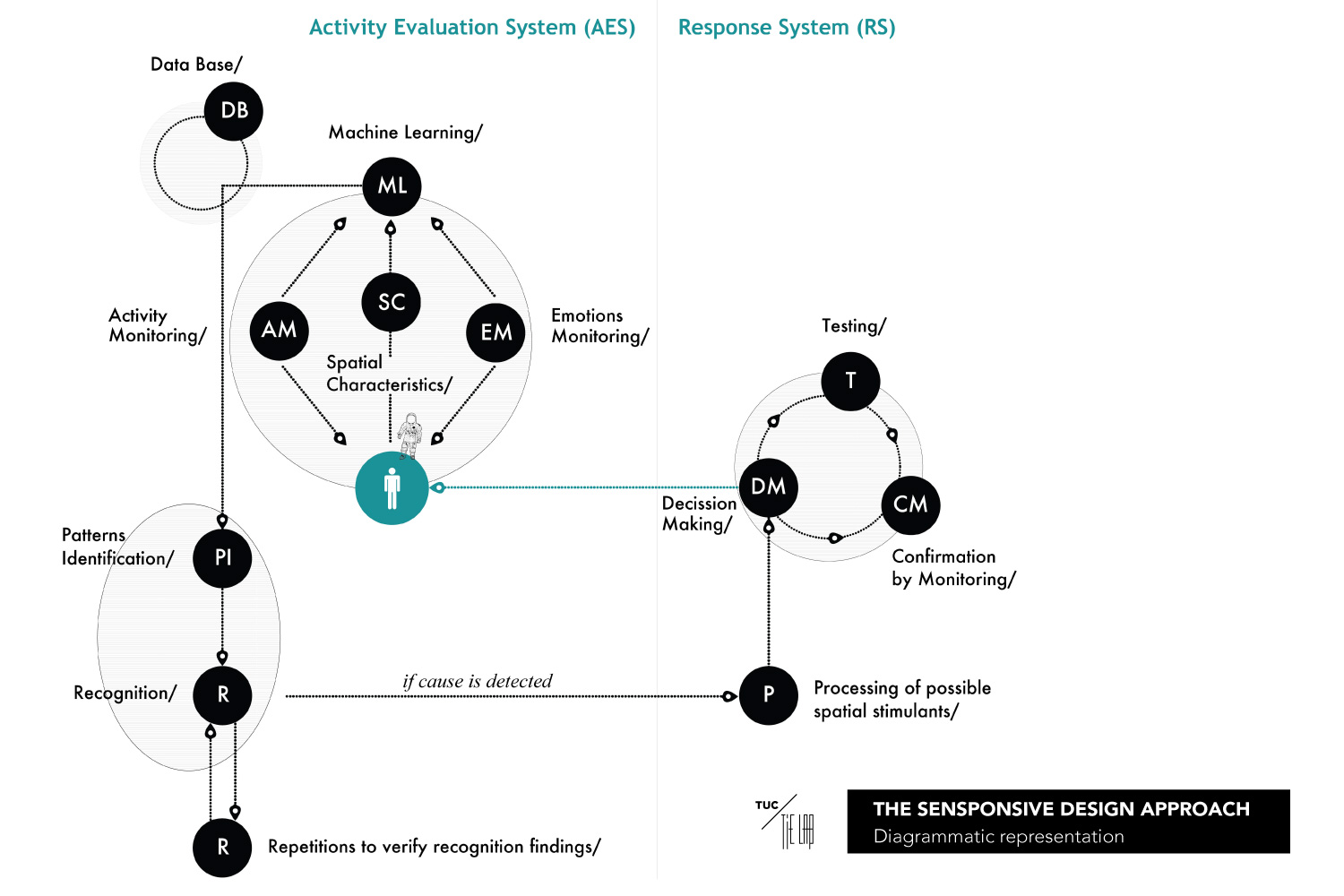THE
SENSPONSIVE
DESIGN
APPROACH
TUC TIE Lab Design Research
The integration of Information Technology (IT) in architecture during the last decade has opened up a path to the creation of Schodek’s “empathic” space within which human activities can be understood in the appropriate context by a system [1]. Along this path, sensponsive architecture targets the emergence of a spatial, assistive 'consciousness' that is seamlessly integrated into human daily environments. Sensponsiveness adopts the Ambient Intelligence (AmI) framework of ubiquitous, yet invisible, computing to orchestrate the collaborative function of technological systems that collect human-activity and environmental related data, assess it based on qualitative factors and direct the appropriate spatial and ambient changes within the augmented architectural space.
The sensponsive logic is defined by three basic characteristics: time, understanding and intention. Time refers to the act of providing a spatial response in a timely fashion, understanding refers to the act of monitoring and perceiving the context within which a response will take place, while intention refers to the act of assembling a pattern of specific responses, appropriate for the conditions and the respective context. Time can also refer to delay, which is the time required for a ‘thinking’ entity to assess a situation, prior to understanding. In order to avoid too much complexity, the act of understanding aims to recognize specific human activities and behaviors that are deemed important by the designer. Those three characteristics facilitate the design of spatial behavior. Following are the basic components for the operation and set up of a sensponsive architectural space:
- Activity Evaluation System (AES).
Initially it is important to identify the type and the intensity of the human activities that take place, in relation to time, inside a specific environment. The designer can then set the environmental qualitative characteristics s/he wishes to make responsive. - Dynamic Building Program (DBP).
It is a flexible diagrammatic process, which changes in real-time, as it is linked to the AES. It is developed to re-configure its measurements every time the activities and the environmental conditions change. In its current state of development the DBP application examines the relation between optimum arrangements and existing conditions to produce visualizations that highlight the deviations calculated by the system. The purpose is not data precision but the development of a tool that provides better knowledge of space utilization and highlights ways toward efficient solutions in future design. It also enables the design of reconfigurable settings that can adapt to changing spatial requirements. [2] - Responsive System (RS).
This system has two modes of operation. The first one is the interactive mode and it is fully controlled by the user. During this mode, spatial changes take place instantly in order to provide the best arrangement that supports the human activities hosted within. Re-configurable, kinetic spatial elements allow people to make the appropriate modifications within the allowances of the design. The second mode is the sensponsive one. In this mode, the designer shapes the core of the sensponsive behavior. The main attributes that define the performance of human activity are monitored in the most unobtrusive way possible. After a process of evaluation, the system decides whether a spatial intervention is necessary. Evaluation is a difficult task because it carries a high level of objectivity. However, a combination of participatory design, machine learning and argumentation processes can facilitate a self-regulating process. [3] This is when the ‘responding with sense’ mode manifests itself through the understanding factor, based on intention. The RS employs flexible spatial configurations, smart materials, projections and speakers in order to perform environmental changes, both spatial (regarding volume and/or surface) and ambient (regarding audio, visual, olfactory, and haptic conditions). - Formation and Reconfiguration.
This is the architectural core component of the sensponsive framework and it involves a vertical operation, affecting all parts of the system. It has the form of a comparative dynamic database of optimum spatial solutions. It provides the optimum spatial features -functional, aesthetic and symbolic- related to specific human activities. In this step, a variety of spatial formations and reconfigurations are designed based on the data acquired from the DBP. This step is actually responsible for the initial spatial arrangements of the interactive phase and the micro-adjustments of the sensponsive phase. The spatial features are divided into two main categories, material and ambient, directed by both the designer and the users. The basic actions are a) identify and set qualitative elements (lighting, temperature, acoustics, ventilation, colors and virtual perspective) and b) identify and set spatial characteristics (geometry, perspective, volume, surface, spatial landmarks in the actual perspective and smart materials to reduce energy consumption). It is very important in this component to consider the “human-in-the-loop” mode, during which the system is calibrating itself constantly in regard to people’s behavior in space [4].
Key aspect in the sensponsive design approach is the creation of an interior space that is capable of providing discreet environmental responses with seamless, smooth transitions within a sensible context, formed knowingly around the activities of the people without alarming them. From there on, it is an issue of programming and algorithmic design using tools from the broader area of Artificial Intelligence (AI), and more specifically the domains of Machine Learning, State Estimation, and Decision Making. The aforementioned steps can be achieved only through a human-centered approach. In order to explore this path in an applicable way, Oungrinis and Liapi have been conducting research within two very specific environmental contexts that have a clearly stated purpose and therefore facilitate experimentation and evaluation at this stage.
The first research project involves habitats in extreme environments where the main goal is to maintain the physiological comfort and psychological balance of the crew within their confined isolation [5]. The Intelligent Spacecraft Module (ISM) project is conceptualised and designed to facilitate augmented habitability conditions in the extreme confinement of long-duration space missions in Low Earth Orbit, to Moon, Mars and beyond. The ISM design approach deals with functional and quantitative issues in order to facilitate the everyday living activities quite straightforwardly, with both low-tech and high-tech features that employ transformability and spatial economy techniques. Qualitative issues are addressed inside the astronauts’ private quarters, where the sensponsive operation is active and provides a series of subtle, customizable spatial and ambient 'stimulants' known to have a direct positive effect on a person’s mood [6]. The primary objective that the ISM serves is to help astronauts adapt in their microgravity habitat through a technology-mediated process that transforms their concept of the interior space (a metric concept) into a personalized and comfortable for the body and the mind place (a mental concept).
The second research project is located in the field of educational spaces where the main objective is the creation of an environment that can best suit different types of teaching methods, while maintaining key characteristics for human activity, such as attention and learning clarity. The Spirit|Ghost (S|G) project aims to provide an operational paradigm as it demonstrates a space that integrates IT systems to assist in the efficiency of the educational process. The sensponsive operation here is divided in two main phases. The first one, dubbed Spirit, monitors the human activities within space, identifies their context and evaluates the existing spatial configuration in terms of hosting and facilitating them, providing it that way with the element of sense (logos). Spirit has a mission to comprehend, not to engage in a reaction. If there is cause for intervention, the second phase, dubbed Ghost, takes place with active spatial and environmental changes. The name is influenced by the global presence of animism in cultures. This provided us with the psychological context in which people can react positively within a sentient changing environment, as well as with the theoretical framework to develop specific human-computer interaction protocols.
The path to explore the sensponsive design direction intersects with many other scientific fields where ‘knowledge confluence to the design activity’ is observed [7]. It requires rigorous research on the ‘state-of-the-art’ to address issues of accurate context specification, identification of appropriate technologies, scripting and software development, fabrication and system integration. Only through this knowledge can optimum design methodologies be developed. Furthermore, tools and solutions are often located at the most unlikely ‘places’ or in the combination of (seemingly) unrelated elements.
Working in stages is crucial to handle this complexity and to highlight easier the next steps. The operational scaled models provided this research with a platform for individual system-testing and better visualization of the project as a sum of parts. Testing this approach in small segments is feasible and produces valid proof of concept. Regarding the efficiency of the environments’ “output”, a parallel research is being conducted to measure the exact impact of the proposed discreet environmental changes on people, through field experiments. With the use of environmental projections, VR and EEG equipment, the authors have been developing a database regarding the relations between spatial environmental conditions and people’s attention, memory, arousal and mood.
The potential of the sensponsive design framework is evident in the aforementioned projects because of a critical feature for architectural solutions: the ability to measure and adjust the efficiency of space, and thus to successfully implement an artificial environment, which is a capability provided by the activity-based design process and the logic that supports it. The design goal evaluation is also a very important aspect, because it can provide architects with the ability to understand the efficiency of their design and actively continue to pursue their goals even at a post-occupancy phase.
The sensponsive approach aims to be an effective solution for increasing the quality of life in a measurable way, as well as for spatially addressing issues related to well-being and comfort. It is a long path, along which architecture cannot remain an autonomous discipline. But this is not a negative fact, as collaboration with other disciplines is always a positive influence, as it provides fresh perspective and inspiration for achieving the ‘next logical step’ and advance the context and the practice of architecture to reach Sloterdijk’s “ambient spheres for life”[8].
In-text references
- Addington, M. and Schodek, D., Smart Materials and Technologies for the Architecture and Design Professions, Architectural Press, Oxford, 2005.
- Oungrinis, K.-A. and Kokkalis, S., Dynamic Building Program: A New Method to Produce Building Programs with the Implementation of Time-Relevant Factors, in: Proceedings of the International Conference on Adaptation and Movement in Architecture (ICAMA2013), Ryerson University, Toronto, 2013, 34-43.
- Moraitis, P. and Spanoudakis, N., Argumentation-based Agent Interaction in an Ambient Intelligence Context, in: IEEE Intelligent Systems, Special Issue on Argumentation Technology, 22(6), 2007, pp. 84-93.
- Dimitrakakis, C. and Lagoudakis, M.G., Rollout Sampling Approximate Policy Iteration, in: Machine Learning, 72 (3), 2008, pp. 157-171.
- Oungrinis, K.-A., Liapi, M., Gkologkina, E., Kelesidi, A., Linaraki, D., Paschidi, M., Gargalis, L., Klothakis, A. and Mairopoulos, D., Intelligent Spacecraft Modules: Employing User-Centered Architecture with Adaptable Technology for the Design of Habitable Interiors in Long-Term Missions (IAC-13,E5,2.1x18985), in: Proceedings of the 64rd International Astronautical Congress, Beijing, China, 2013. (Digital publication).
- Vakoch, D.A., ed., Psychology of Space Exploration, NASA, Washington, DC, 2011.
- Sprecher, A., LIFE in:formation, On Responsive Information and Variations in Architecture, in: Proceedings of the 30th Annual Conference of the Association for Computer Aided Design in Architecture, ACADIA, New York, 2010, 10-13.
- Sloterdijk P., Essai d’Intoxication Volontaire, Hachette Literature, Paris, 2000.
PUBLICATIONS
Oungrinis, K.-A. and Liapi, M. (2014). Spatial elements imbued with cognition: A possible step toward the "Architecture Machine." International Journal of Architectural Computing (IJAC) 4(12), Multi-Science Publishing, 419-438.
PROJECT TEAM
KONSTANTINOS-ALKETAS OUNGRINIS
MARIANTHI LIAPI


